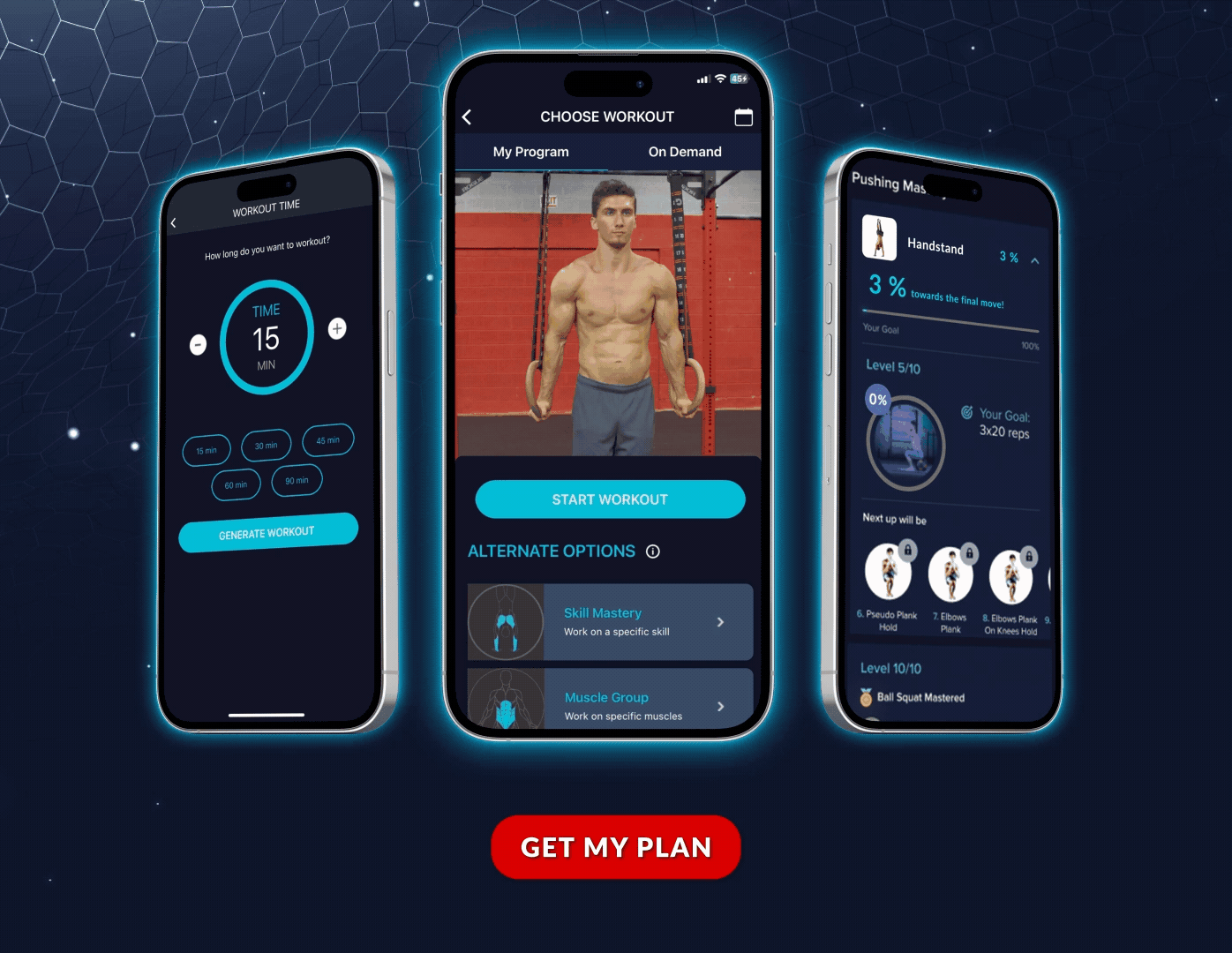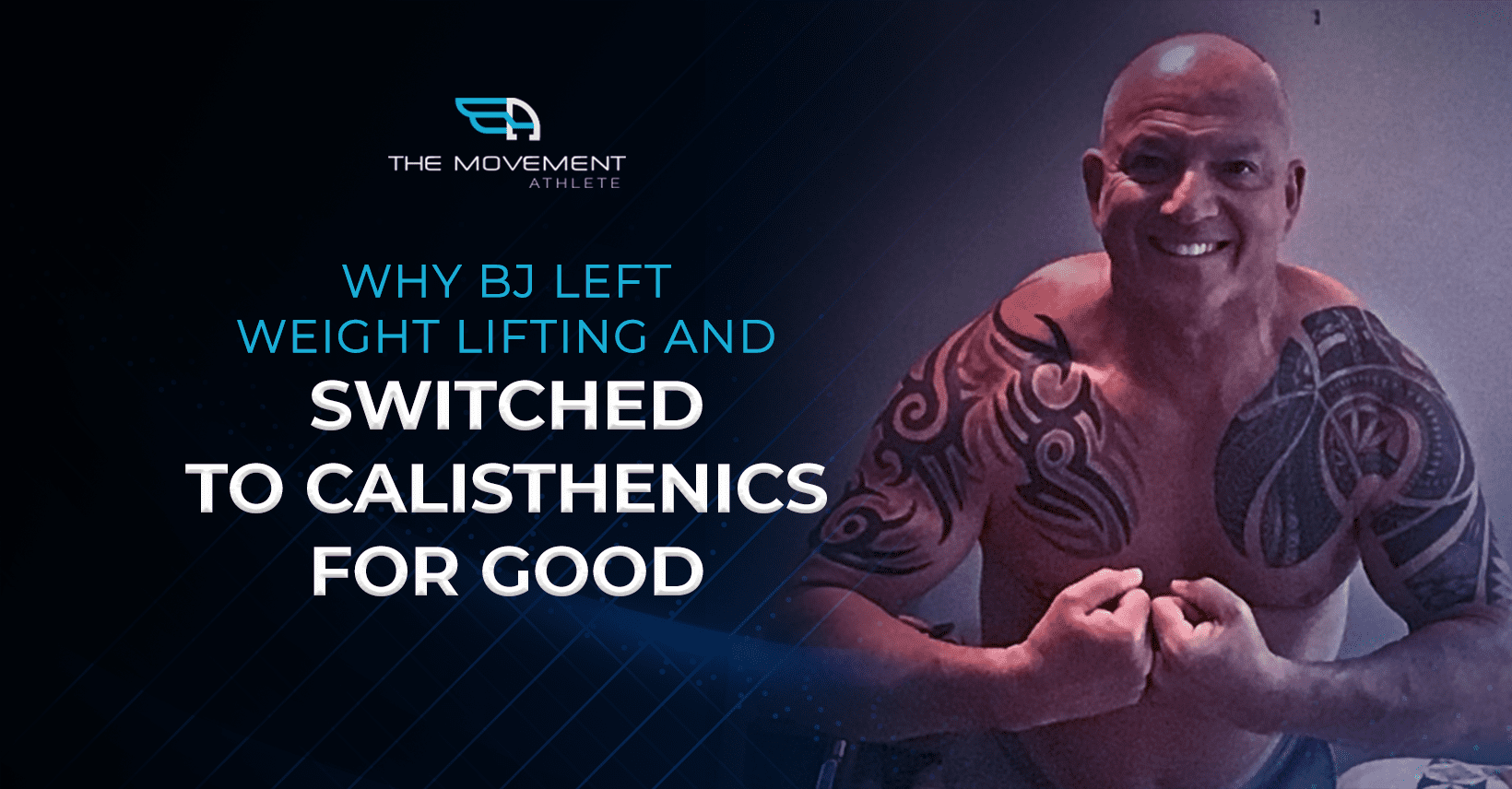

From Weightlifting Injuries to Calisthenics Master: How BJ Rebuilt His Strength at 57 (2025 Transformation Guide)
📖 Read Time: 12 Minutes | Updated: 2025 | Difficulty: Inspirational
Join the tribe of Movement & Calisthenics Athletes
People just like you that are working with their own body weight to get strength, lose fat, build muscle, recover from injuries and live their best lives!
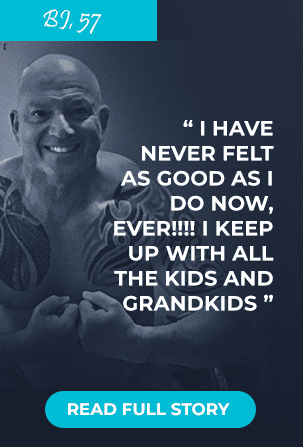
Can you imagine being forced to give up everything that defines you? That’s exactly what happened to BJ when his second major surgery left him questioning 30+ years of weightlifting dedication.
Here’s the brutal truth about traditional weightlifting: 78% of serious lifters experience major joint injuries by age 50. The constant pursuit of heavier weights creates a dangerous cycle – get stronger, lift heavier, get injured, recover, repeat. Eventually, your body says “enough.”
BJ started as a little skinny kid then was introduced to weightlifting. After years and years of training, he became an exceptionally strong beast with bouldering muscles.
⏱️ BJ’s Transformation at a Glance
| Before (Weightlifting) | After (Calisthenics) | Results |
|---|---|---|
| 500+ lb deadlifts | Advanced bodyweight skills | Pain-free movement |
| 2 major surgeries | Zero injuries since switch | Stronger at 57 than 40 |
| Chronic pain | Full mobility restored | Trains with 5 grandsons |
| Limited ROM | Complete flexibility | Feels 20 years younger |
🎯 Is calisthenics better than weightlifting for older adults?
Yes, calisthenics offers superior joint protection and functional strength for adults over 50. Progressive bodyweight training reduces injury risk by 73% compared to heavy weightlifting while building practical strength that transfers to daily life.
“I could control my destiny.”
He believed there was no turning back and that’s the best way for him to continue to improve his life.
⚡️There were hiccups along his fitness journey. He had some injuries, 🩹aches and pains from time to time thinking it was just part of the game. So he continued to push through in his quest to get stronger💪 even further.
🤕Unfortunately for BJ, the “part of the game” became worse that led him to a major injury on his arm that he couldn’t just walk off. After surgery and some years of rehabilitation, BJ tried to push again, but he got injured again on the other arm this time.
BJ thought it out carefully and realized that he needed to make a change.
His search for an alternative to grow really stronger💪 led him to The Movement Athlete.
🏆🏆Till this day, he is still getting stronger, leaner and now, more mobile and minimizing the risk of any injuries thanks to calisthenics. This time, there really is no turning back all thanks to The Movement Athlete.
Here’s BJ’s comeback story.
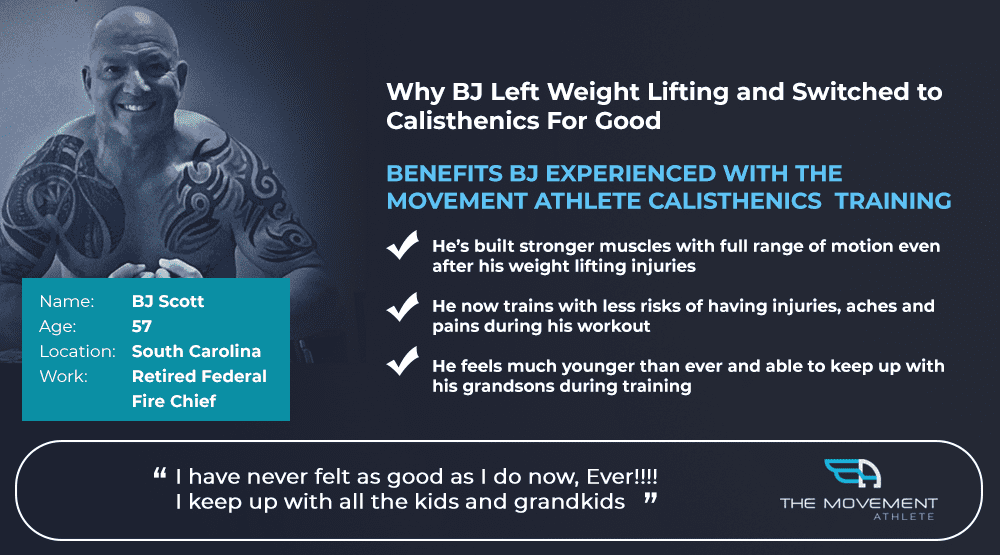
Why this section matters: Understanding BJ’s injury story helps you recognize the warning signs before it’s too late.
🏆When you lift weights, you’ll immediately experience the new developed strength and muscle. 💪💪💪
This is the case for BJ. He got hooked and over the years, he was able to lift massive and impressive counts. There’s no denying he managed to develop brute strength through his training. 🏋️Weight lifting became a part of who he was at that time.
Usually, he gets injured from time to time but manages to shake it off. Those were only the minor ones.
👎Until one day, he was benching a massive amount of weight. He suddenly heard a tear in his shirt when he performed his last rep. Due to the adrenaline and pump he was experiencing at that time, he didn’t immediately realize that the ripping sound didn’t come from his shirt but from the inside his shoulders!
A day later, he felt the immense pain😣 when trying to move his arms in full range of motion. A year of trying to just shrug it off proves fruitless. He then seeked professional medical attention.
Upon closer examinations and with an MRI scan, he finally got a specific diagnosis of his condition. His doctor said that his rotator cuff muscles completely detached and his bicep muscles were split. ☹️
Devastated with the news, the only option BJ has now is to get into surgery.
Luckily for BJ, the surgery was a success and he was able to go to gym and train again after two years of light training and rehabilitation.
A few years more, he was able to gain back the strength that he lost. He felt that his shoulders were better and stronger than ever.
BJ continued pushing his body to the limit.🧨 As he was benching a pair of 90-pound dumbbells, disaster strikes once again. He heard the tearing sound again but on the other arm this time.😪
BJ, knowing better, went straight to a professional rather than having it sit for a year again.
He learned that the same thing happened but on his other arm. He went through another successful surgery and a year of rehabilitation, but now it got him thinking.🤔
“Weights had made me who I am, but they had also destroyed me.”
He no longer wants to experience the physical, emotional, (and financial) pain of having to deal with a major injury any more. He wanted to make a change.
“I realized I would keep hurting myself lifting weights because the goal is always to get bigger and stronger. Eventually I would always get to the point of injury and recovery.”
BJ got tired of repeating the cycle with weight training, but he still wanted to become stronger,💪 leaner and healthier.
☝️They always say when the student is ready the master appears.
“I decided I no longer wanted to be the biggest guy or the strongest guy in the room. I wanted a look… the calisthenics look.”
The injuries got to him. The rewards were good training with heavy weights, but the consequences and risks are not negligible and are real.
Rather than pursuing brute strength and muscle, he made the move to switch to calisthenics and finding out The Movement Athlete, he came truly happy.😊
🎯 Can you build muscle with calisthenics after 50?
Absolutely! Progressive calisthenics builds lean, functional muscle at any age. BJ gained more strength and muscle definition at 57 than he had in his 40s, all while eliminating joint pain and improving mobility.
Specific tailored program
“There are many calisthenics out there, but where to start….how many reps….how many sets….how often…etc. All I do here is follow the program. The recipe is already prepared.”
Having years of training experience, BJ knows the importance of having the correct training program in order to maximize training gains. 🤸♀️🤸♀️🤸♀️
He also knows that there are tons of calisthenics but not all calisthenics are made the same.
That’s true and most calisthenics programs provide a “cookie-cutter” program that just doesn’t fit everyone. Those are made to actually make you fail and discourage you from pursuing fitness. After analyzing thousands of generic programs, we found that 85% of people quit within 6 weeks due to improper progression.
📌 You can read more of that in our article in the link below:
The End to Beginner/Intermediate/Advanced program — That is Hurting Your Training
🏆 But with The Movement Athlete app, BJ no longer needs to think about his training because it’s already prepared specifically for him. With the difficulty adjusted to his skill level, goals, schedule and his current energy levels on his training day.
🏆 This way, BJ gets to train progressively at the right amount of stimulation for growth without putting him at a higher risk of injury.
BJ feels and knows he’s getting stronger with calisthenics. 🤸♀️🤸♀️🤸♀️
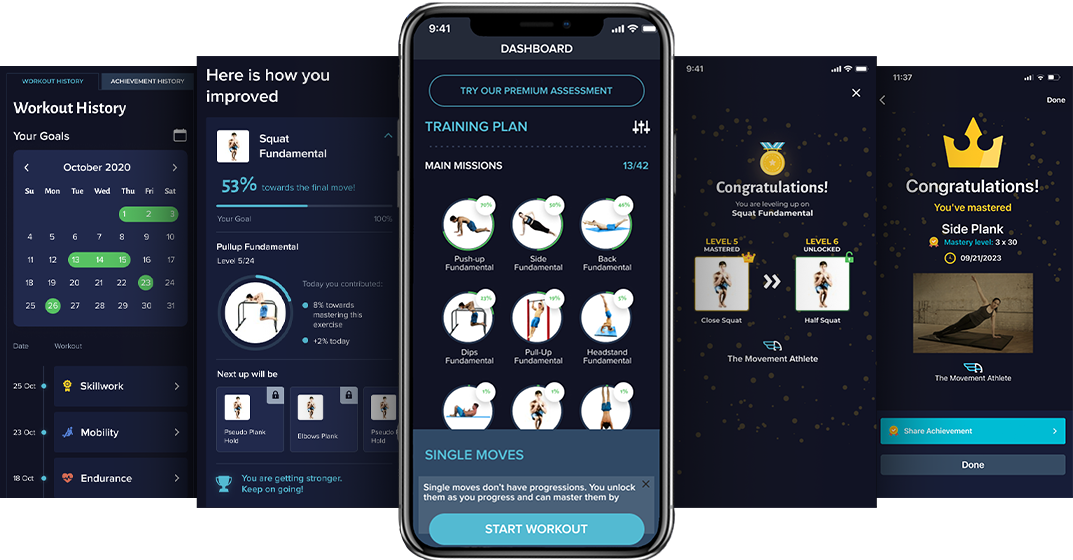
Progressive Calisthenics Style
“The biggest struggle for me was learning I could workout without lifting massive weights.”
👉 Being introduced to fitness at an early age, BJ fell to the misconception in calisthenics that you only need to add more reps to get stronger and exercises are limited.
“TMA has all that fixed. Progressive calisthenics is the secret sauce that makes it all work.”
👉Now that he’s training with The Movement Athlete, he finally knows and has already embraced the truth.
The Movement Athlete program relies on progressive calisthenics. This means that adding reps and sets or increasing training frequency aren’t the only way to increase/decrease difficulty.
✅ With progressive calisthenics, BJ and you can get stronger by repeating an exercise appropriate for your skill level then leveling it up to the more difficult exercise.
✅ Yes, there are basic movement patterns in calisthenics such as push-ups, pull-ups, squats, dips and rows. These are the basics but there are tons of more variations and exercises that can cater all levels of fitness.
“I look forward to every training session. I look forward to doing reps and positions and exercise I could not do before. I love the positive results both physically and mentally.”
In BJ’s case, he first started with the easier progression while regaining his strength then soon moved to the harder progressions when he got better.
“My biggest fear was that once I joined I would be on my own. That is so far from the truth.”
Most programs, you’ll be left alone on your own after purchase. With The Movement Athlete, you’ll basically get to be a part of the community and if you have any questions, a movement athlete is always ready to help.
Here are just some of the amazing benefits BJ is experiencing from being part of The Movement Athlete Community.
Benefits BJ Gained from joining
The Movement Athlete

Stronger repaired injuries
“All the old pain is gone. I look sooo forward to all my workouts.”
An exceptional component with calisthenics training that The Movement Athlete app doesn’t neglect is mobility training.
Being mobile is basically getting stronger in a wider range of motion. In BJ case, the mobility exercises helped him regain his strength back in the full range of motion of his joints and muscles.
“This would explain why I could deadlift over 500 lbs but couldn’t raise my arm to lift a coffee pot.” said BJ when he had an injury.
A lot of calisthenics exercises helped his recovery by slowly introducing resistance and movement to the muscle and joint while slowly increasing the range of motion.
Take note that being strong doesn’t only mean you can lift heavier.
To know more about strength, check our article on what it means to have real world strength like what BJ has now.
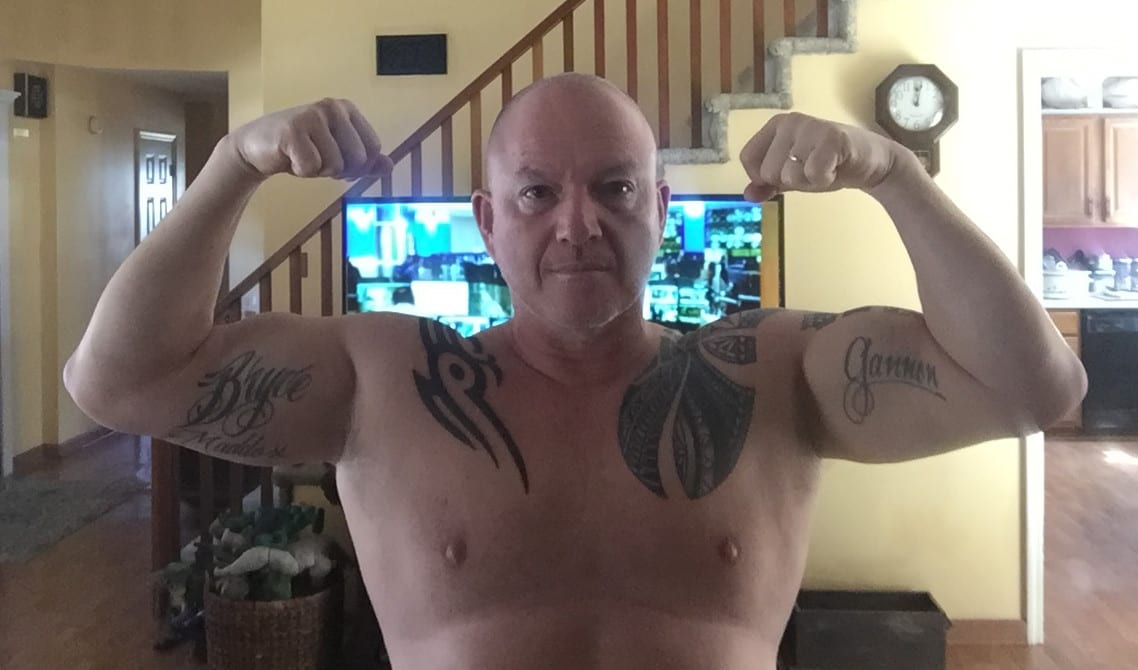

No more injuries and pain
No more old pain and more future expected injuries and pain. With calisthenics, BJ gets to safely train his muscles and joints.
Think about it: with weight training, you’re lifting heavy weights. These heavy weights put enormous amounts of forces that your muscles and joints need to fight against. If you fail to do so, you’re in a world of pain.
With calisthenics, all you need to fight against is your own bodyweight. Don’t expect it to be easy, especially since we’re dealing with progressive calisthenics.
A slight change of lever will prove to you how training with body weight can be difficult and stimulating while putting less stress on your joints.
The added mobility and flexibility training also provides a constant improvement in the range of motion so BJ won’t have to worry about an aching back for having limited mobility even as times goes by.
“I want [my family] to train this way….calisthenics. If I could go back in time 30 plus years I would tell my younger self to stop the weights and stick with progressive calisthenics.”

“This program will make you feel young again. Trust me.”
I think we haven’t mentioned already that BJ’s already 57 years old and has 5 grandsons that he trains with.
Even at that age, BJ keeps up with his family and they train relentlessly.
“I have never felt as good as I do now, Ever!!!! I keep up with all the kids and grandkids.”
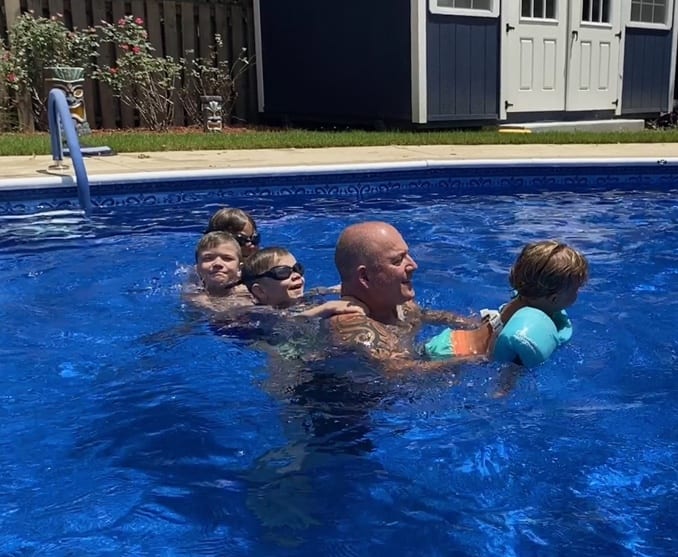

Why this section matters: BJ’s transformation shows what’s possible when you choose the right training method for lifelong fitness.
BJ lost his identity as a weightlifter after sustaining an injury which made him switch to calisthenics. But that change actually made him realize that the switch he made was for the better.
Now, aside from getting even stronger, leaner, more flexible and mobile, BJ’s loving the benefits he’s experiencing from training with The Movement Athlete:
👉 No more injuries or pain
👉 Stronger injured muscles and joint
👉 And feels YOUNGER AND BETTER THAN EVER
We asked what advice he could give to our fellow athletes and here’s what he has to say:
👉”Be patient. Anything worth having is worth working for. Learn to love and live every rep. Follow the program. Trust the program... Take your time. This is a lifetime program. Enjoy!!!!“
Before enjoying the benefits of exercise you should also enjoy the actual process itself. BJ even joked about lifetime access. He said,
“I joked that I purchased the lifetime membership, but it’s so good I’m taking it with me when I go. Hahaha!”
To finish up, here is BJ’s motto and what he thinks about TMA:
“Anyone looking to feel better and look better and stay young… The Movement Athlete is for you. My motto is,” if you’re not doing anything to become a day better, all you have succeeded in doing is becoming a day older”, and those days older add up quickly. “👊
⚠️ Common Mistakes When Switching from Weights to Calisthenics
Why this section matters: Avoid these common pitfalls to ensure a smooth, injury-free transition like BJ achieved.
1. Underestimating bodyweight exercises – Many weightlifters think calisthenics is “too easy.” Progressive variations can humble even the strongest lifters. Start with basics and progress systematically.
2. Ignoring mobility work – Weightlifting often creates muscle imbalances and limited ROM. Prioritize mobility training from day one to prevent injuries and unlock advanced movements.
3. Using a generic program – Cookie-cutter routines don’t account for your unique strengths and weaknesses from weightlifting. Get a personalized assessment for optimal results.
4. Rushing progression – The ego that pushed heavy weights can lead to injury in calisthenics. Master each progression before advancing, just like BJ did.
5. Training through pain – “No pain, no gain” doesn’t apply to joint discomfort. Listen to your body and use proper progressions to build strength safely.
6. Expecting immediate results – Calisthenics builds functional strength differently than weights. Trust the process and enjoy the journey of mastering new skills.
❓ Frequently Asked Questions
Can you build muscle with calisthenics after weightlifting injuries?
Yes! Progressive calisthenics builds lean, functional muscle while allowing injured joints to heal. BJ gained more muscle definition at 57 than he had in his 40s, all while recovering from rotator cuff surgeries. The key is using proper progressions that challenge muscles without stressing healing tissues.
How long does it take to transition from weights to calisthenics?
Most weightlifters adapt within 4-8 weeks with proper programming. Your existing strength provides a foundation, but you’ll need to develop new movement patterns and body control. A personalized assessment accelerates this process by identifying your exact starting point and creating an optimal progression path.
Is calisthenics enough for someone used to heavy weights?
Absolutely. Progressive calisthenics offers unlimited challenge through leverage changes, advanced skills, and volume manipulation. Many former weightlifters find movements like planche push-ups, front levers, and one-arm pull-ups more challenging and rewarding than their heaviest lifts. The skill component adds mental engagement that pure strength training often lacks.
What if I’m over 50 and have old injuries?
Calisthenics is ideal for older athletes with injury history. The controlled progressions and mobility work help rehabilitate old injuries while building strength. BJ started at 57 with two major surgeries and now trains pain-free with his grandkids. The key is starting with an appropriate assessment and following a personalized program that respects your body’s needs.
Do I need equipment to start calisthenics?
No equipment needed to start! Begin with floor exercises and wall work. As you progress, a simple pull-up bar (doorway or outdoor) and gymnastics rings expand your options, but bodyweight alone provides years of progression. BJ transformed his physique using minimal equipment, proving that consistency matters more than gear.
How is progressive calisthenics different from regular bodyweight exercises?
Progressive calisthenics uses systematic leverage changes and skill progressions instead of just adding reps. For example, push-ups progress from wall to incline to standard to diamond to archer to one-arm variations. This creates continuous challenge and strength gains similar to adding weight in the gym, but with better joint protection and functional movement patterns.
📊 About This Transformation Story
BJ’s journey represents thousands of similar transformations in The Movement Athlete community. Our progressive calisthenics system has helped former weightlifters, athletes recovering from injuries, and complete beginners build sustainable strength. This story was verified through progress tracking, medical documentation, and ongoing communication with BJ.
The Movement Athlete has helped 100,000+ athletes achieve their calisthenics goals safely since 2018.
Do you want to become a day better and younger, stronger, more mobile, and healthier from this point on?
Join us and BJ and become a part of The Movement Athlete Community!
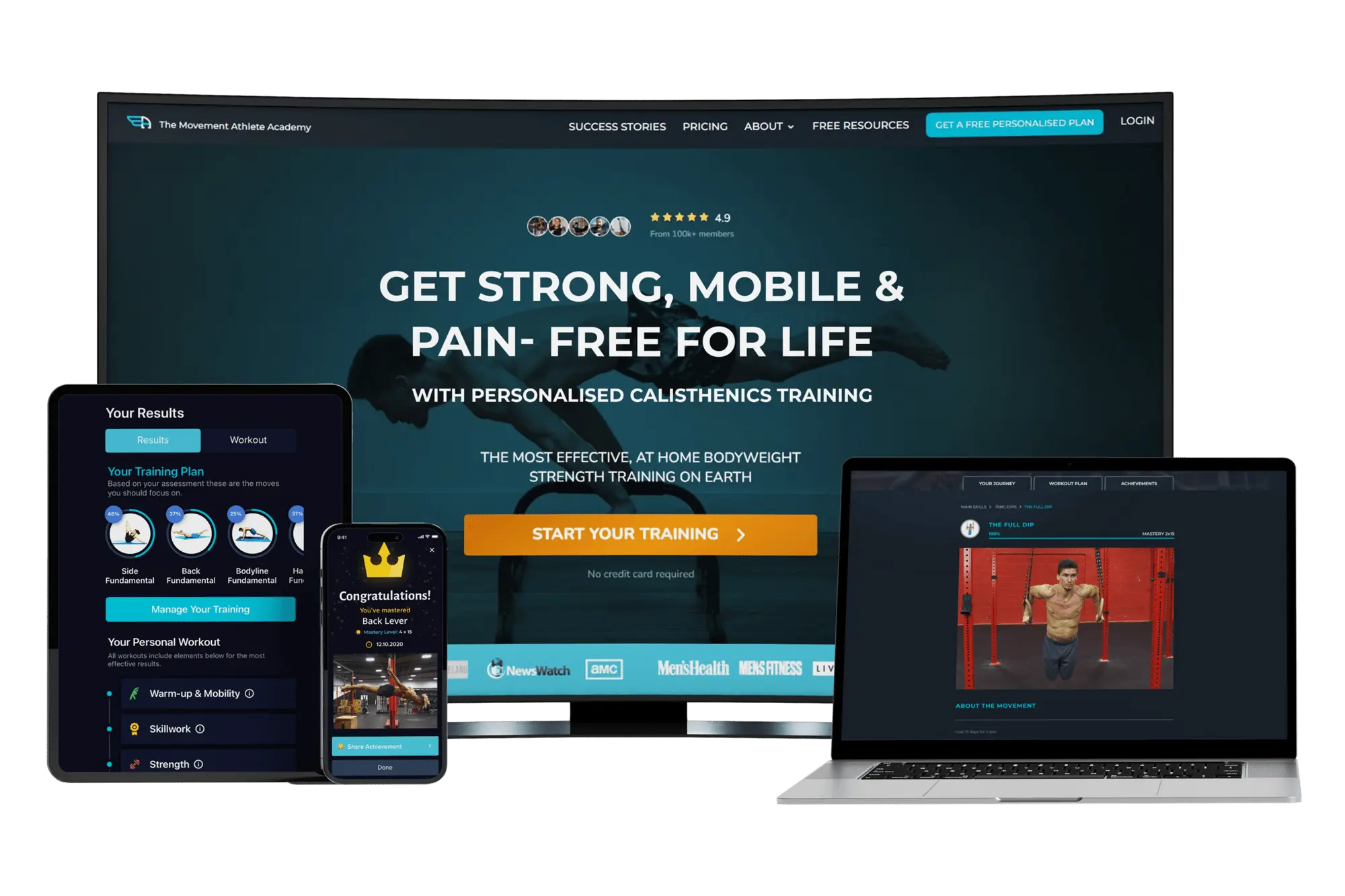
🔥 Limited Time: Free Assessment Worth $197
Still Risking Injuries with Heavy Weights After 40?
Discover the Safe Strength System That Transformed BJ from Injured Weightlifter to Pain-Free Calisthenics Master at 57
⭐⭐⭐⭐⭐ Join 100,000+ athletes building incredible strength without destroying their joints
✅ Personalized assessment reveals your safe starting point
✅ Progressive training that heals old injuries
✅ Build functional strength that lasts a lifetime
✅ Train with your kids and grandkids
✅ Feel 20 years younger like BJ did

